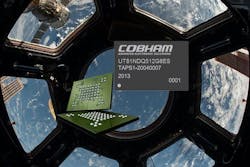High-density NAND flash data storage for radiation-tolerant space applications introduced by Cobham
COLORADO SPRINGS, Colo. – Cobham Advanced Electronic Solutions in Colorado Springs, Colo., is introducing the UT81NDQ512G8T high-density NAND flash memory device for demanding space applications.
The 4-terabit triple-level cell NAND flash memory module delivers 32 times the density of the closest competing device while fitting into the same industry-standard 12-by-18-millimeter plastic-encapsulated microcircuit package.
With access to this kind of data storage capacity, designers can increase sensor and digital signal processing in applications such as solid-state drives and recorders, reconfigurable computing systems, imaging, and communications data buffering applications.
Related: The need for trusted data storage
The module performs as many as 667 mega-transfers per second and complies with Open NAND Flash Interface 4.0 and JEDEC NAND Flash Interoperability (JESD230C) specifications.
While aerospace designers must screen commercial-grade NAND flash to estimate radiation tolerance and operational lifetime, the Cobham radiation-assured flash modules undergo extensive pre-testing for total ionizing dose and single-event effects characterization on a wafer lot-by-lot basis.
Cobham also applies parts, materials and process failure-mode analysis to monitor for potential variations in the semiconductor fabrication process.
Related: Security and solid-state media driving data storage
The UT81NDQ512G8T 4-terabit NAND flash module supports NV-DDR3 I/O at 667 mega-transfers per second, NV-DDR2 I/O at 533 mega-transfers per second, asynchronous I/O at 50 mega-transfers per second, and TLC endurance of 3,000 program and erase cycles.
The module operates across 2.7-to-3.6-volt input and 1.14-to-1.26-volt, or 1.7-to-1.95-volt output voltage ranges and specified to a temperature range of -40 to 85 Celsius. The 132-ball grid array module is available now in engineering units, with flight models to be released in the second quarter of 2021.
For more information contact Cobham Advanced Electronic Solutions online at www.cobhamaes.com/space.
